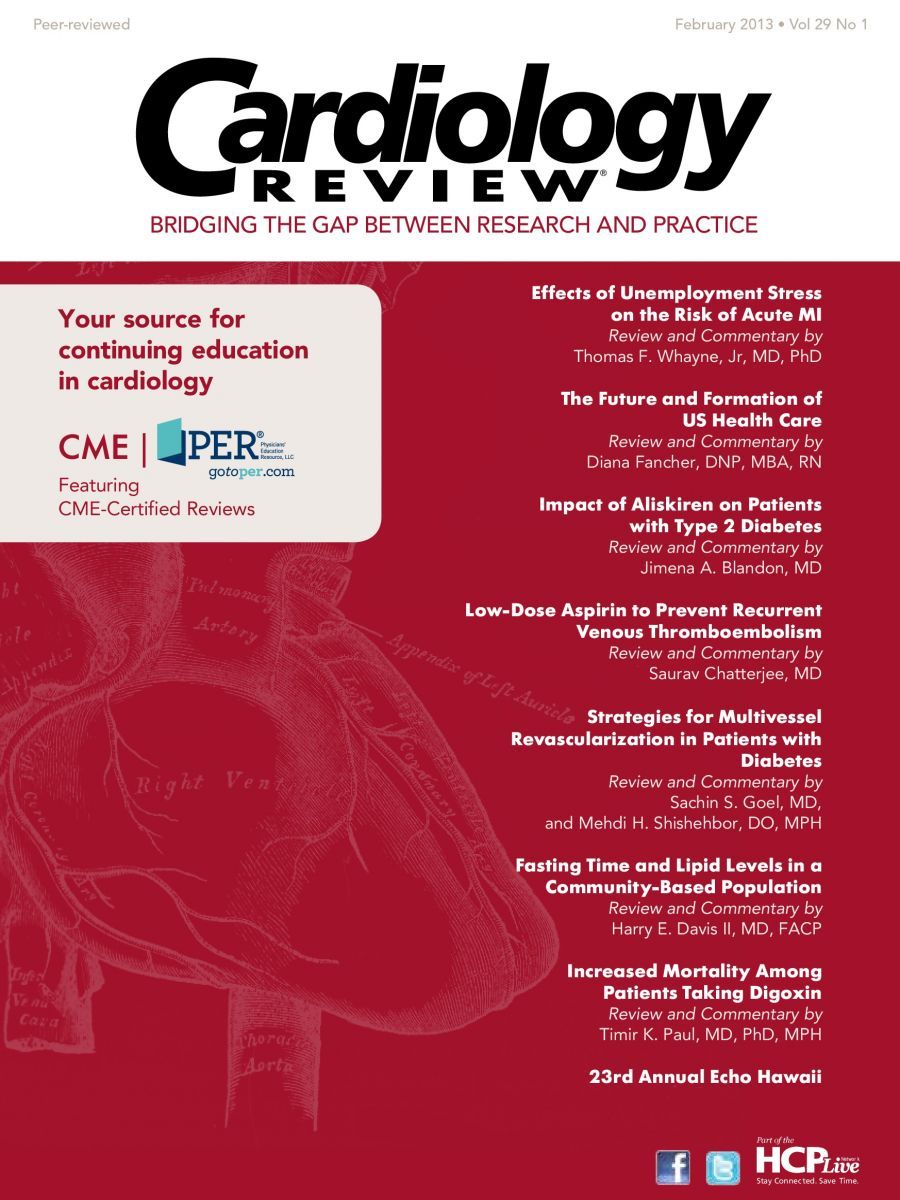Publication
Article
Should Concerns About Developing Diabetes Impact the Use of Statins?
In this new department in Cardiology Review, we ask several clinicians to answer a question of current interest to health care practitioners. Please send your comments and suggestions for future topics to Editor-in-Chief Dr Debabrata Mukherjee at: debabrata.mukherjee@ttuhsc.edu.
Q: Should concerns about developing diabetes impact the use of statins?

Tracy E. Macaulay, PharmD, AACC , BCPS
(AQ Cardiology)
University of Kentucky Health Care
Lexington, KY
A: In 2008 the Rosuvastatin to Prevent Vascular Events in Men and Women with Elevated C-Reactive Protein Trial (better known as JUPITER) demonstrated that rosuvastatin was beneficial in the primary prevention of cardiovascular disease in atrisk individuals.1 Although the study received a lot of press, perhaps one of the more heavily debated findings was the demonstration that rosuvastatin-treated patients were also more likely to have physician-reported new-onset diabetes (0.030% vs 0.024%, P = 0.01).
As far as objective evidence to support these findings, there was no difference in fasting glucose or glycosuria, but there was a statically significant difference in A1C (5.9% vs 5.8%, P = 0.001). Further analysis by the same team published in Lancet in 2012 showed that those who developed diabetes during the study follow-up had 1 or more diabetes risk factors at baseline and, importantly, had a cardiovascular and mortality benefit similar to the intention-to-treat population.2 One could easily argue that with in-depth analysis of a study this large (17,802 participants), findings can be statically significant and not necessarily be clinically important. Although many clinicians believed this to be the case with the original JUPITER trial, the findings were appropriately hypothesis-generating and led to further investigations. A metaanalysis of 13 clinical trials by Sattar et al3 investigating the association of diabetes and statin use that collectively enrolled over 90,000 patients demonstrated the actual risk increase of new-onset diabetes to be around 0.09% in statin-treated participants (1.22% vs 1.13%; odds ratio [OR], 1.09; 95% confidence interval [CI], 1.02-1.17).
The authors’ conclusions were cautious, describing the slight association, but emphasizing the benefit of statin therapy, and recommending no change in practice. However, these findings did result in a change in statin labeling by the FDA, which now warns of the increased incidence in new-onset type 2 diabetes in statintreated patients. The lay press also took note, resulting in much discussion as to whether statins should be used more cautiously.
Although safety surveillance is important, particularly with such a widely utilized class of medications, many conclusions have now been made based on evidence that is not entirely up to the rigorous standards for which the cardiology community prides itself. For example, there was no trial-specified definition of diabetes uniformly pressed upon the investigators in JUPITER. Nor is a meta-analysis the prospective evaluation that a question of this importance might deserve. Many questions remain that simply cannot be answered by a meta-analysis; for example, were each of the 13 included trials equally regimented about tracking of blood glucose (at baseline and throughout) or were other known diabetes contributors controlled for adequately? That being said, given the vast numbers of patients included in these evaluations, there certainly appears to be an association between diabetes and statins. Importantly, in neither JUPITER nor the subsequent meta-analysis did this linkage alter the morbidity and mortality benefits incurred by statin users in these high-risk patient populations.
Therefore, use of statins in populations similar to those studied and in whom treatment benefits have been shown is important. However, these studies’ findings are yet another indication that we do not entirely understand all the mechanisms underlying statin therapy. And to that end, the “put them in the water” approach to prescribing statins is also not supported by clinical evidence. Use of statin therapy in less carefully evaluated low-risk individuals may also not be prudent, as some have suggested.
The most interesting juxtaposition posed by this question—“Should concerns about developing diabetes impact the use of statins?”—is that once a patient develops diabetes (statin instigated or not), is there a better-known medication to prevent the vascular complications of diabetes than an HMG co-A reductase inhibitor? Not even most medications designed and developed to treat diabetes have had as great an impact on the course of cardiovascular complications as statins have had. So, it is my wholehearted opinion that concerns over the development of diabetes should certainly NOT impact the use of statins. But as always, use of statins should mirror the clinical trial populations in which any hazard of developing diabetes was outweighed by the cardiovascular benefit.
References
1. Ridker PM, Danielson E, Fonseca FA, et al. Rosuvastatin to prevent vascular events in men and women with elevated C-reactive protein. N Eng J Med. 2008;359:2195-2207.
2. Ridker PM, Pradhan A, MacFadyen JG, et al. Cardiovascular benefits and diabetes risks of statin therapy in primary prevention: an analysis from the JUPITER trial. Lancet. 2012;380: 565- 571.
3. Sattar N, Preiss D, Murray HM. Statins and risk of incident diabetes: a collaborative meta-analysis of randomised statin trials. Lancet. 2010;375:735- 742.

Rabab Mohsin, MD
Cardiology Resident
Texas Tech University Health
Sciences Center
El Paso, TX
A: In the early 1950s, the act of adding fluoride to the drinking water supply to prevent tooth decay became the official policy of the US Public Health Service. Over the past 20 years, the popularity of statin therapy has physicians and medical experts theorizing about the possibility of adding statins to our water supply due to their proven and substantial cardiovascular benefits.
Today, preventive medicine is at the forefront of healthcare policies, and statins have become one of the most promoted medical therapies to reduce cardiovascular events in multiple patient populations. Many physicians and health care experts have hypothesized that early initiation of statin therapy would reduce cardiovascular risk effectively. One of the most aggressive management plans for lipid control is directed to the diabetic population.
In recent years, meta-analyses and clinical trials have raised a concern that statins can potentiate the incidence of diabetes. Sattar et al recently explored 13 clinical trials that enrolled more than 90,000 patients and found that there was a 9% increased risk of developing diabetes while on statin therapy. However, the absolute incidence of diabetes did not change, and the patients were shown to have a reduction in coronary events.1
The 2008 American Diabetes Association’s (ADA’s) standards of care call for an initiation of statin therapy for all patients with diabetes. A “treat-to-target” approach for low-density lipoprotein (LDL) of <100 mg/dL is used in addition to lifestyle therapy in the ADA guidelines versus an evidence-based “fixed-dose” approach.2 In the JUPITER trial, there was a significant but mild increase in new-onset diabetes in patients started on rosuvastatin (3% vs. 2.4% in placebo).3 It has been observed in many of the statin studies that the average BMI was over 24 kg/m2, which adds to the development of diabetes. Small observational and cohort studies have shown that all statins are not created equal and have different adverse effects on glucose metabolism.4
The pleiotropic effects of statins, including a reduction of inflammation, plaque stabilization, a reduction in microvascular complications, and reversal of endothelial dysfunction, have all been implicated as beneficial phenomena to reduce cardiovascular risk.2 A final point to address would be the intensivedose therapy versus low-dose therapy in the development of diabetes. In Preiss et al’s meta- analysis of 5 statin trials, which included approximately 33,000 patients without diabetes at baseline, 8.4% were found to have new-onset diabetes.5 The intensive-dose statin therapy was associated with increased risk of diabetes as compared with moderate-dose therapy.
Regardless of the mild increase in the diabetic population observed in the above studies, the substantial benefit in reducing cardiovascular events leaves the prescriber utilizing statins both for primary and secondary prevention. The most important guideline is to use good clinical judgment and close followup when prescribing statins in preventive medicine. It is a good reminder to healthcare staff that statins are an adjunctive therapy to lifestyle changes, including encouragement of daily exercise. Although adding statins to the public water supply may not be the best application of preventive medicine, statins remain a proven therapy for patients with cardiovascular risks.
References
1. Sattar N, Preiss D, Murray H, et al. Statins and risk of incident diabetes: a collaborative meta- analysis of randomised statin trials. Lancet. 2010;375:735-742.
2. Eldor R, Raz I. American Diabetes Association indications for statins in diabetes: is there evidence? Diabetes Care. 2009;32(supp 2):S384-S391.
3. Ridker PM, Danielson E, Fonseca FA, et al. Rosuvastatin to prevent vascular events in men and women with elevated C-reactive protein. N Eng J Med. 2008;359:2195-2207.
4. Belalcazar LM, Raghavan VA, Ballantyne CM. Statin-induced diabetes: will it change clinical practice? Diabetes Care. 2009;132:1941-1943.
5. Preiss D, Seshasai S, Welsh P, et al. Risk of incident diabetes with intensive-dose compared with moderate-dose statin therapy: a meta analysis. JAMA. 2011;305:2556-2564.

Karla K. Quevedo, MD
Cardiology Fellow
Texas Tech University Health
Sciences Center
El Paso, TX
A: Chronic diseases, such as heart disease, stroke, cancer, diabetes, and arthritis, are among the most common, costly, and preventable health problems in the United States. Heart disease, cancer, and stroke account for more than 50% of all US deaths each year. From 1980 through 2010, the number of adults in the United States between the ages of 18 to 79 with newly diagnosed type 2 diabetes mellitus more than tripled from 493,000 in 1980 to over 1.7 million in 2010. Adults with diabetes are 2 to 4 times more likely to have heart disease or a stroke than adults without diabetes. The American Heart Association considers diabetes to be one of the 6 major controllable risk factors for cardiovascular disease.
Coronary heart disease has been directly linked to disorders of metabolic homeostasis, which are characterized by endothelial dysfunction and insulin resistance. The overall benefits observed with statins seem to be greater than would be expected from lowering lipid levels alone, suggesting statins’ effects beyond cholesterol control. These cholesterol-independent or “pleiotropic” effects of statins involve improving endothelial function, enhancing the stability of atherosclerotic plaques, decreasing oxidative stress and inflammation, and inhibiting the thrombogenic response. These properties of statins have not being completely elucidated.
Statins may regulate normal glucose metabolism in either beneficial or adverse ways. One of the newest and more controversial effects is the development of new-onset type 2 diabetes mellitus. Statins, particularly at a high dose, may cause unfavorable pleiotropic effects such as impairment in insulin secretion and worsening of insulin resistance.
Statins’ effects related to worsening insulin resistance are:
• inhibition of glucose-stimulated elevations of free calcium in the cytoplasm of beta cells, leading to impaired insulin secretion;
• down-regulation of expression of the insulin- responsive glucose transporter GLUT4 and up-regulation of glucose transporter GLUT1;
• and inhibition of isoprenoid biosynthesis, an intermediate product of cholesterol formation.
In order to determine whether individual statins may have differential effects on insulin sensitivity in patients without pre-existing diabetes mellitus, a systematic review and metaanalysis was conducted through December 2008.1 Each statin was analyzed separately versus placebo. Pravastastin significantly improved insulin sensitivity, atorvastatin and rosuvastatin tended to mildly worsen insulin sensitivity, and simvastatin significantly worsened insulin sensitivity. This systematic review and meta-analysis demonstrates that statins do not have a “class effect” on insulin sensitivity in patients without diabetes.
Another meta-analysis of randomized controlled trials suggest potential differences between individual statins, with pravastatin showing a trend toward a reduction in risk and atorvastatin, rosuvastatin, and simvastatin together demonstrating a significant increase in risk versus placebo.2 A recent meta-analysis reported that statin therapy is associated with a 9% increase in risk for incident diabetes. Risk of development of diabetes with statins was highest in trials of older patients.3 The 2 trials with the lowest calculated occurrence of diabetes (AFCAPS/TexCAPS and WOSCOPS) were primary prevention trials with low diabetes risk.4,5 The 4 trials with the highest frequency of incident diabetes included participants known to be at high risk of diabetes: PROSPER (participants were 70 to 82 years of age with or at high risk of cardiovascular disease), GISSI Prevenzione (myocardial infarction within the last 6 months), GISSI HF, and CORONA (patients with heart failure, a well-known diabetogenic state).6-8 Studies have also shown some evidence of a dose-dependent association of statin use with development of type 2 diabetes. Use of higher-dose statin compared with a moderatedose statin has been associated with a higher incidence of new-onset diabetes.9
These multiple trials highlight the need for more prospective, large, randomized clinical trials to examine the effects on overall mortality as well as cardiovascular and metabolic morbidity with the use of different statins. Until then, it is difficult to weigh the risk of adverse metabolic consequences of statins against their beneficial effects on cardiovascular events. Whether new-onset diabetes or worsening of diabetes is causally related to cardiovascular outcomes remains unknown. Clinical trials designed to maintain optimal glucose control in a diabetic population have shown a reduction in the incidence of myocardial infarction, suggesting that glucose itself might play some role in the physiopathology of cardiovascular disease.
Even with the possible side effect of statins worsening glycemic control and increasing the risk of new-onset type 2 diabetes mellitus, the risk of statin use remains absolutely outweighed by the cardiovascular benefit in patients with an indication for statin use. One important consideration that can be extrapolated from this new evidence is that statin use should not being recommended for patients at low cardiovascular risk or patients in whom cardiovascular benefit has not been proved and in whom a potential risk for development of diabetes has to be considered. The magnitude of statins’ benefit matches or exceeds benefits with other secondary prevention medications such as aspirin, ß-blockers, and angiotensin-converting enzyme inhibitors in patients after myocardial infarction. In clinical practice, statins are still recommended for primary and secondary prevention of coronary heart disease.
References
1. Baker WL, Talati R, White CM, Coleman CI. Differing effect of statins on insulin sensitivity in non-diabetics: a systematic review and meta-analysis. Diabetes Res Clin Pract. 2010;87:98- 107.
2. Koh KK, Sakuma I, Quon M. Differential metabolic effects of distinct statins. Atherosclerosis. 2011;215:1-8.
3. Sattar N, Preiss D. Statins and risk of incident diabetes: a collaborative meta-analysis of randomized statin trials. Lancet. 2010;375:735-742.
4. Primary Prevention of Acute Coronary Events with Lovastatin in Men and Women with Average Cholesterol Levels Results of AFCAPS/TexCAPS. JAMA. 1998;279:1615-1622.
5. West of Scotland Coronary Prevention Group. West of Scotland Coronary Prevention Study: identification of high-risk groups and comparison with other cardiovascular intervention trials. Lancet. 1996;348: 1339-1342.
6. Pravastatin in elderly individuals at risk of vascular disease (PROSPER): a randomized controlled trial. Lancet. 2002;360:1623-1630.
7. Effect of rosuvastatin in patients with chronic heart failure (the GISSI-HF trial): a randomized, double-blind, placebo-controlled trial. Lancet. 2008;372:1231-1239.
8. Effects of Statin Therapy According to Plasma High-Sensitivity C - reactive protein Concentration in the Controlled Rosuvastatin Multinational Trial in Heart Failure (CORONA). Circulation. 2009;120:2163-2165.
9. Preiss D, Welsh P. Risk of incident diabetes with intensive-dose compared with moderate-dose statin therapy. JAMA. 2011;305:2556-2564.






